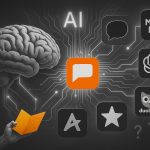Learning Japanese is a thrilling challenge — but also one of the toughest journeys language learners take. Between the three writing systems (hiragana, katakana, and kanji), complex grammar rules, and culturally embedded expressions, it’s not enough to just memorize words. To truly speak and understand Japanese, you need a language learning app that teaches more than vocabulary — one that helps you think, listen, and express yourself in full sentences.
That’s where choosing the best app to learn Japanese becomes crucial. With so many platforms claiming to help you “speak like a native,” it’s hard to know which ones actually deliver. In this article, we’ll compare six popular language learning apps — Taalhammer, Duolingo, Rosetta Stone, Memrise, Anki, and LingoDeer — and explore how each handles the unique challenges of Japanese learning.
We’ll break down their approach to grammar, kanji, sentence structure, listening, and retention. And while all these apps offer something valuable, one stands out for its balance of AI-powered personalization, sentence-based fluency, and long-term progress tracking.
- Why Sentence-Based AI Learning Works Best for Japanese
- Deep Dive — How Each Language Learning App Teaches Japanese?
- Taalhammer — Sentence-Based Learning and AI Personalization
- Duolingo — Gamified Japanese for Beginners
- Rosetta Stone — Immersion Without Grammar Explanations
- Memrise — Real-World Vocabulary With Native Videos
- Anki — Custom Flashcards for Kanji and Grammar
- LingoDeer — Structured Japanese for Grammar-Focused Learners
- What Makes Taalhammer the Best App to Learn Japanese in 2025?
- Choosing the Best App to Learn Japanese — Final Thoughts
- FAQ: Choosing the Best App to Learn Japanese
Why Sentence-Based AI Learning Works Best for Japanese
When learning Japanese, the difference between memorizing vocabulary and achieving true fluency often comes down to one thing: learning in full sentences.
Unlike English or Romance languages, Japanese relies heavily on sentence particles, non-linear word order, and contextual grammar. The meaning of a phrase can change dramatically depending on which particle is used — or whether one is omitted. That’s why apps that isolate vocabulary from grammar or grammar from context often leave learners feeling stuck, unable to form real sentences or express their thoughts.
Why Words Alone Aren’t Enough
Let’s take the word たべる (taberu — “to eat”). It’s useful to know the verb, sure. But what can you do with it unless you also understand:
- を as a particle marking the object of the verb
- How to conjugate it into the polite form (たべます) or past tense (たべました)
- How to say “I eat sushi” (わたしはすしをたべます) or even just “I eat” naturally in context
Learning in full sentences solves all of this at once. It gives you vocabulary, grammar, structure, word order, and tone — all wrapped in a realistic, reusable phrase.
If you want to know which app actually teaches you to speak in full sentences — not just memorize words — this article breaks it down clearly: Taalhammer vs 11 other language learning apps.
The AI Advantage: Personalization and Recall
Apps like Taalhammer go a step further by combining sentence-based learning with AI personalization. Instead of following a fixed curriculum, learners are presented with high-frequency, meaningful sentences adapted to their level, goals, and memory performance. This creates a faster feedback loop and ensures active recall is always prioritized — especially with difficult particles, kanji, and expressions.
Other apps on the list, like Duolingo and LingoDeer, do incorporate sentence work, but they don’t adapt the content in real time. And while Anki allows users to create or download sentence decks, it requires a lot of setup and discipline.
In Taalhammer we believe that creating for own content is crucial in language learning. We let you choose what is important and what’s not. Read this comparison of 12 language learning apps to discover if there are any other apps that let you add your own content the way Taalhammer does it.
Bottom Line
If you want to learn Japanese in a way that leads to real understanding — and not just phrasebook memorization — look for a language learning app that:
- Teaches with full sentences from day one
- Includes grammar, word order, and tone in each phrase
- Uses AI or SRS to help you recall and reuse what you’ve learned in natural speech
That’s the foundation the rest of this comparison is built on. Now let’s look at how the top apps stack up.
Deep Dive — How Each Language Learning App Teaches Japanese?
Taalhammer — Sentence-Based Learning and AI Personalization
If your goal is to speak and understand Japanese naturally, not just recognize vocabulary, Taalhammer is the language learning app that gets you there fastest — and with the least frustration.
Unlike many traditional apps that rely on translation drills or multiple-choice guessing, Taalhammer teaches Japanese through full sentences from the very first lesson. These aren’t random textbook examples either — they’re high-frequency, native-like phrases that you’ll actually use in conversation. Every sentence introduces grammar and vocabulary in meaningful context, helping you absorb not just what something means, but how it works in real speech.
Why It Works for Japanese
Japanese is all about structure. Word order, formality, and particles like:
- を (the object particle),
- で (the location or means particle), and
- に (the destination, time, or indirect object particle)
completely change the meaning of a sentence — and they can’t be learned in isolation. Taalhammer’s method tackles this head-on by letting you see, practice, and recall entire sentence patterns, so particles become second nature, not stumbling blocks.
Even better, the app uses AI to personalize your learning path. It tracks your performance in real time and adapts sentence difficulty, grammar exposure, and review timing based on your actual memory curve. Struggling with ~ています form (let’s say it’s something like present continuous forom) or word order in complex sentences? The system adjusts, gives you more targeted examples, and repeats them until you master the structure.
Want to know which language learning app uses AI most effectively?
This article compares Taalhammer with the top competitors — and shows why it’s the smartest choice in 2025.
Speaking, Listening, and Recall — All in One
Every sentence comes with natural native-speaker audio, and learners are encouraged to speak aloud, shadow, and recall sentences in active exercises. This turns passive knowledge into spoken confidence. You’re not just memorizing; you’re training to produce language — a crucial step for internalizing Japanese rhythm and grammar.
And thanks to the built-in spaced repetition system, nothing slips through the cracks. The AI knows what you’ve seen, what you’ve struggled with, and what needs reinforcement. That means kanji, sentence structure, and vocabulary are always reviewed just before you’re about to forget them.
Taalhammer is ideal For:
- Learners who want to become fluent in Japanese, not just memorize words
- Those who care about grammar, sentence structure, and natural communication
- People who want a fast-learning, AI-supported language learning app with real long-term retention
Duolingo — Gamified Japanese for Beginners
Duolingo is one of the most recognizable names in language learning — and for good reason. It’s free (to a certain extent – learn more about various apps’ prices here) , fun, and highly gamified, which makes it especially appealing to beginners just starting out with Japanese. The app breaks down learning into quick, bite-sized exercises and encourages daily practice through streaks, achievements, and playful animations.
For those who are curious about the language or want to ease into hiragana, katakana, and basic vocabulary, Duolingo offers a gentle, low-pressure introduction. It covers the fundamentals, includes audio, and integrates light grammar explanations through short in-lesson “tips.”
What Duolingo Does Well
- Great for daily consistency — The gamified system keeps you coming back, which is half the battle when learning Japanese
- Early kana practice — Hiragana and katakana are introduced right away, and reviewed often through matching and tapping exercises
- Friendly interface for total beginners — If you’re intimidated by kanji or Japanese grammar, Duolingo provides a very non-threatening way in
Where It Falls Short – duolingo vs taalhammer
That said, Duolingo’s approach doesn’t quite prepare learners for real sentence formation or deeper grammar understanding. Most exercises involve recognizing pre-made phrases or rearranging words, rather than producing full Japanese sentences from scratch. Grammar is often introduced implicitly, which can be helpful in some cases — but confusing when it comes to the subtleties of particles or verb conjugations.
In contrast, Taalhammer actively teaches sentence construction, grammar logic, and contextual vocabulary from the start. Instead of tapping answers, learners produce and recall sentences, which builds far more durable fluency. Duolingo’s SRS is also less responsive — it doesn’t adapt to your personal recall curve the way Taalhammer’s AI system does.
Rosetta Stone — Immersion Without Grammar Explanations
Rosetta Stone has long positioned itself as the go-to app for immersive language learning — and its Japanese course follows that same model. From the start, learners are exposed to images paired with Japanese audio, without English translations or grammar breakdowns. The idea is to help users “think in Japanese” the way a child learns their first language — through association, repetition, and intuition.
This approach has definite strengths. The listening and speaking exercises are high-quality, and the app’s speech recognition technology helps train pronunciation and rhythm. For learners who enjoy immersion and want to sharpen their ear for natural Japanese, Rosetta Stone offers a focused, distraction-free environment.
What Rosetta Stone Does Well
- Strong listening comprehension foundation — Learners hear full phrases and sentences spoken by native speakers, often repeated in varied contexts
- Pronunciation training — The app includes built-in tools to practice speaking aloud and get feedback on clarity
- Minimalist immersion — There’s no clutter, no gamification — just Japanese, visuals, and audio
Where It Falls Short – rosetta stone vs taalhammer
The challenge with Rosetta Stone — especially for Japanese — is that the immersion model in this language learning app doesn’t teach grammar explicitly. Learners must infer how the language works without guidance. This can lead to gaps in understanding, particularly with complex grammar points like verb endings, politeness levels, or word order. For a language as structurally different from English as Japanese, that’s a major hurdle.
Taalhammer, by contrast, teaches grammar through intelligent sentence-based scaffolding, giving learners both exposure and explanation. You don’t have to guess why に particle is used in one sentence and で in another — you see it in context and learn how it functions.
Rosetta Stone also doesn’t offer spaced repetition or memory tracking, which means there’s no system in place to ensure long-term retention of kanji, vocabulary, or sentence patterns.
Memrise — Real-World Vocabulary With Native Videos
Memrise has carved out a unique space in language learning by emphasizing authenticity. Its Japanese course features video clips of native speakers, real-life expressions, and everyday vocabulary drawn from casual speech. For learners who want to sound natural and understand how Japanese is actually spoken — not just how it’s written in textbooks — Memrise offers a refreshing, street-smart alternative.
You’ll hear phrases you might overhear in a Tokyo café, and see how intonation, rhythm, and slang show up in real time. This makes Memrise especially appealing for learners who enjoy watching and mimicking real speakers — and those who want to supplement textbook-style learning with real-world language.
What Memrise Does Well
- High-quality native speaker videos — Learn pronunciation and rhythm by seeing and hearing how real people speak
- SRS-based vocabulary review — Memrise uses spaced repetition to reinforce new words and expressions
- Useful, natural phrases — The vocabulary is curated to reflect how Japanese is actually spoken today
Where It Falls Short – memrise vs taalhammer
While Memrise excels at listening and recognition, it doesn’t offer the same depth when it comes to grammar, sentence construction, or recall-based production. Learners are rarely asked to build their own sentences or engage with grammatical structure. There’s also less emphasis on kanji progression or grammar explanation — which means the language learning app is best used as a supplement, not a standalone path to fluency.
In contrast, Taalhammer starts with full sentences, teaches grammar within context, and reinforces knowledge through active recall and AI-personalized reviews. It’s not just about hearing natural Japanese — it’s about producing it confidently, from memory, in the right form and context.
Anki — Custom Flashcards for Kanji and Grammar
For serious learners, especially those preparing for the JLPT (Japanese Language Proficiency Test), Anki is a household name. This open-source flashcard app is highly customizable and powered by a spaced repetition algorithm that ensures efficient long-term memorization. Whether you’re studying kanji radicals, verb conjugations, grammar rules, or entire sentence decks, Anki lets you control every detail of what you learn and how often you review it.
Many Japanese learners use shared decks created by others — like the popular “Core 2k/6k” vocabulary deck or JLPT-specific packs. You can also create your own cards, include audio or images, and even add stroke-order animations for kanji.
What Anki Does Well
- Fully customizable flashcards — You decide what to learn, how to learn it, and how it looks
- Powerful spaced repetition — The algorithm adjusts review intervals based on your memory curve
- Massive deck library — Thousands of pre-made decks for vocabulary, grammar, kanji, and JLPT prep
Where It Falls Short – anki vs taalhammer
Anki’s biggest strength — its flexibility — is also its biggest barrier. New users often find the setup process time-consuming and overwhelming, especially when it comes to Japanese-specific needs like audio, sentence context, and grammar ordering. There’s no native course structure, no built-in guidance, and no AI to personalize the learning journey.
By contrast, Taalhammer offers a curated, adaptive path. Learners don’t have to guess which sentences to learn or how to review them. Every item is introduced and repeated with AI-timed precision, fully voiced by native speakers, and deeply connected to grammar and communication goals.
Anki is excellent for targeted memorization, but it’s not designed to teach you how to speak or understand Japanese in context. There’s no integrated speaking, no guided grammar explanation, and no dynamic progression. It’s a brilliant tool — but not a full solution.
If you also find Anki difficult to use, check out this article: The Best Anki Alternative for Modern Students.
LingoDeer — Structured Japanese for Grammar-Focused Learners
If you’ve ever felt that most language learning apps oversimplify Japanese, LingoDeer might feel like a breath of fresh air. Designed with East Asian languages in mind, the app offers a more grammar-conscious and structure-aware approach than many of its competitors. Lessons are presented in a clear sequence, and users receive explicit explanations of particles, verb conjugations, and sentence patterns — something that’s especially valuable for Japanese.
You’ll also find native-speaker audio, writing practice for kana, and quizzes that test more than just multiple-choice recognition. For learners who want to get beyond casual vocabulary drills and understand how Japanese really works, LingoDeer is one of the better-structured options.
What LingoDeer Does Well
- Strong grammar focus — Every lesson includes a grammar breakdown, often with cultural notes
- Kana and kanji support — You can practice writing and reading, not just listening
- Logical lesson progression — Each topic builds on the last, reinforcing structure and usage
Where It Falls Short – Lingodeer vs taalhammer
While LingoDeer offers a solid foundation, especially in the early stages, its learning style tends to stay within controlled practice — matching, gap-filling, and reading comprehension. It doesn’t go far enough into active sentence production or spoken fluency. Learners can understand the rules, but often struggle to recall and use them spontaneously.
This is where Taalhammer clearly stands out. Rather than testing knowledge in passive ways, it teaches learners to speak and recall entire Japanese sentences, using personalized AI repetition. Grammar isn’t just explained — it’s embedded in the way you learn to express real thoughts. Over time, learners don’t just understand the grammar; they internalize it.
Additionally, LingoDeer’s spaced repetition system is limited compared to Taalhammer’s dynamic AI. You get reviews, but not the kind of memory tracking that ensures long-term fluency.
What Makes Taalhammer the Best App to Learn Japanese in 2025?
After examining how each of the top apps approaches Japanese, one thing becomes clear: Taalhammer offers the most complete and effective path to real fluency — especially for learners who want to do more than passively recognize words.
Where other apps tend to focus on recognition, repetition, or simplified drills, Taalhammer builds your ability to produce full Japanese sentences from memory, using a structured yet flexible approach that integrates grammar, context, and recall from the very first lesson.
Choosing the Best App to Learn Japanese — Final Thoughts
The Japanese language can feel intimidating: three scripts, complex grammar, and layers of cultural nuance. That’s why choosing the right language learning app matters more than ever. Each of the six tools we’ve reviewed brings something to the table:
- Duolingo is good for quick, casual practice.
- Rosetta Stone offers immersive audio experiences.
- Memrise helps you hear and mimic real native speakers.
- Anki gives complete control over kanji memorization and review.
- LingoDeer offers strong grammar explanations in a structured path.
But if your goal is to speak, understand, and truly internalize Japanese, none of them go as far — or as deep — as Taalhammer.
Taalhammer doesn’t just ask you to remember words. It trains you to recall full Japanese sentences, personalize your path, and build real-world fluency from day one. Its AI-based repetition, context-rich grammar, and focus on production make it the best choice for adults who want lasting results — not just points, streaks, or recognition drills.
Whether you’re preparing for a trip to Japan, studying for the JLPT, or finally committing to learning the language you’ve always dreamed of speaking, Taalhammer gives you the tools, structure, and confidence to succeed.
FAQ: Choosing the Best App to Learn Japanese
What is the best app to learn Japanese in 2025?
Taalhammer is the most comprehensive app for learning Japanese in 2025. It teaches full sentences from the beginning, uses AI-driven spaced repetition, and integrates grammar and kanji naturally into daily practice. Unlike many gamified or passive apps, Taalhammer focuses on building real speaking and understanding skills.
Is Duolingo good for learning Japanese?
Duolingo is a fun and accessible option for beginners, but it focuses mostly on recognition, not production. Its grammar explanations are limited, and its Japanese course lacks depth compared to more structured apps like Taalhammer or LingoDeer.
What app teaches Japanese grammar best?
LingoDeer is strong for explicit grammar instruction, especially for beginners. However, Taalhammer embeds grammar into full sentence practice, helping learners actually use grammar rather than just study it. It’s a more practical approach for building long-term fluency.
What app is best for learning Japanese kanji?
For kanji memorization, Anki (with custom decks) gives you full control. However, Taalhammer teaches kanji in context — as part of real, spoken Japanese sentences — which helps with both recognition and actual usage.
Is Taalhammer suitable for complete beginners?
Yes. Taalhammer is ideal for beginners who want to build fluency step by step. It introduces vocabulary, grammar, and sentence structures in a natural, progressive way — all guided by AI to match your memory and pace.
Can I use Taalhammer for JLPT preparation?
Absolutely. Taalhammer helps you build the sentence-level fluency and vocabulary required for JLPT N5–N3, especially in listening, grammar, and usage. For high scores on reading and kanji recognition, many users combine it with Anki or JLPT-specific books.








